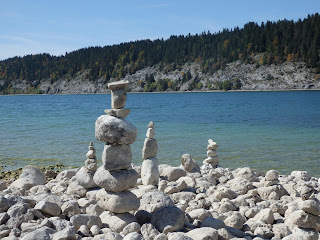Das Cover dieses grossformatigen Bandes stammt aus den 1950er Jahren und wurde von Andrew H. Brown aufgenommen. "'Schneebedeckte Gipfel und rote Scheunen hängen kopfüber im friedlichen Norangsfjord', lautet die Bildunterschrift zu diesem Foto im Januar-Heft 1957 von National Geographic. Das Klima Westnorwegens ist durch den Nordatlantikstrom recht milde, so dass die Bauern immer wieder gute Ernten einfahren können. Man lebt hier jedoch in einer vertikalen Welt, wo schneebedeckte Gipfel Hunderte von Metern in die Höhe ragen und somit ständig die Gefahr von Bergstürzen und Lawinen besteht."
Die Aufnahmen stammen aus der Vor-Handy-Zeit, als die Ausrüstung eines Fotografen recht sperrig und schwer sein konnte. So schleppte etwa Robert F. Sisson eine halbe Tonne nach Ecuador, "wo er 19 Tage neben einer Blume ausharrte in der Hoffnung, ein bestimmter Falter würde sich auf ihr niederlassen – was freilich nie geschah."
Deutschland (DDR), 1973 @ Gordon Gahan/Taschen
Vom Schloss aus betrachtet, verlieren sich die alten Fachwerkhäuser von Stolberg (Harz) im nebligen Tal. der alte Kurort hat den stürmischen Verlauf der deutschen Geschichte weitgehend intakt überstanden. Die Familie des Grafen zu Stolberg-Stolberg wurde 1945 enteignet, als die Stadt der Sowjetischen Besatzungszone zufiel.
Wie schon der National Geographic-Band Asien & Ozeanien zeichnet sich auch Europa nicht nur durch eindrückliche, meist farbige Aufnahmen aus, sondern auch durch höchst informative Bildlegenden (von Mark Collins Jenkins), die weit über die üblichen (meist wenig aussagekräftigen) Legenden hinaus gehen.
Europa beginnt mit Nordeuropa (Dänemark, Färöer, Finnland, Island, Norwegen, Schweden) und wird mit diesem schönen Zitat von Alma Luise Olson vom Oktober 1938 eingeleitet: "Die Finnen sind äusserst nachsichtig, wenn ein Fremder kommt und ein erschreckendes Unwissen über ihr Land offenbart. Sie wissen, dass es fernab liegt. Und sie sind oft die Ersten, die ihr Land als klein bezeichnen." Die Nachsicht in Sachen Unwissen kann ich nur bestätigen, sie gilt auch heute noch. Als ich vor einigen Jahren in Nykarleby (in der Nähe von Vasa) eintraf, hatte ich keine Ahnung, dass in dieser Gegend eine schwedische Minderheit heimisch war – und niemanden schien meine Unwissenheit zu erstaunen, mit Ausnahme von mir selber.
Vereinigtes Königreich (Wales), 1964 @ Thomas Nebbia /Taschen
Junge Wanderer überqueren den Llanberis-Pass im Snowdonia Nationalpark. Um diese Region ranken sich viele Legenden. Der verwundete König Artus, so glauben die Waliser, forderte den Tafelritter Sir Bedivere auf, das Schwert Excalibur in den Glaslyn zu werfen. Dieser 'blaue See' liegt nicht weit von hier. Und unterhalb des Gipfels des Y Liwedd schlafen noch immer die Ritter der Tafelrunde und warten auf die Rückkehr ihres Anführers von der Insel Avalon.
Auf Nordeuropa folgt Osteuropa, das Estland, Georgien. Litauen, Rumänien, das heutige Russland und die frühere Sowjetunion umfasst – eine einzigartige Zeitreise. die auch nostalgische Sehnsüchte aufkommen lässt (nach Menschen, denen die Kamera entweder egal war oder die sich mit einer Unbefangenheit ablichten liessen wie man sich das heute kaum mehr vorstellen kann).
Mitteleuropa schliesst (ich wundere mich, in welch unvertrauter Nachbarschaft sich die Schweiz befindet) Deutschland, Österreich, Polen, Schweiz, Tschechoslowakei, Ungarn mit ein. Ich bestaune einen idyllischen Bootsanlegeplatz am Vierwaldstättersee (in Brunnen, in den 1920er Jahren), eine verschneite Landschaft im Schwarzwald (ebenfalls in den 1920er Jahren) sowie das futuristisch anmutende Sony Center im ehemaligen Todesstreifen und Niemandsland der Berliner Mauer (2015). Meine Lieblingsaufnahme hat James P. Blair 1968 in der Tschechoslowakei aufgenommen, sie zeigt eine friedliche Szene im mährischen Teltsch – als im ganzen Land der Aufstand gegen die sowjetischen Besatzer brodelt, rennen drei kleine Mädchen in Rot vor einer sonnenbeschienenen Fasasade einem roten Ball hinterher.
Italien, 1995 @ William Albert Allard/Taschen
Die italienische Schauspielerin Benedetta Buccellato in ihrer Rolle in Aischylos' Der gefesselte Prometheus.
Westeuropa ist unterteilt in Belgien, England, Frankreich, Irland, Monaco, Niederlande, Nordirland, Schottland und Wales. Präsentiert wird ein Mix von ganz Unterschiedlichem: Für eine Auktion bestimmte Lämmer in Schottland (1983), Körbe und Kisten voller Tulpenzwiebeln in der Lagerhalle eines niederländischen Exporteurs (1977), Zwei junge Damen, die im französischen Saumur ihr Auto an der Ufermauer geparkt haben (1920er Jahre) und und und ...
Südeuropa schliesslich umfasst Albanien, Bulgarien, Giechenland, Italien, Jugoslawien, Mazedonien, Portugal, Spanien, Türkei und Vatikanstadt. Was für eine bunte Mischung! Sie allein lohnt diesen prachtvollen Band!
National Geographic
In 125 Jahren um die Welt
Europa
Herausgegeben von Reuel Golden
Taschen, Köln 2017































































